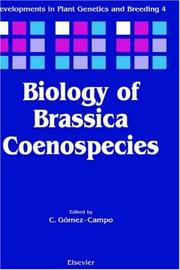| Listing 1 - 10 of 239 | << page >> |
Sort by
|
Periodical
Abstract | Keywords | Export | Availability | Bookmark
 Loading...
Loading...Choose an application
- Reference Manager
- EndNote
- RefWorks (Direct export to RefWorks)
Book
ISBN: 906605820X Year: 1998 Publisher: Wageningen International Society for Horticultural Science
Abstract | Keywords | Export | Availability | Bookmark
 Loading...
Loading...Choose an application
- Reference Manager
- EndNote
- RefWorks (Direct export to RefWorks)
Brassica --- Congresses
Dissertation
Year: 1985
Abstract | Keywords | Export | Availability | Bookmark
 Loading...
Loading...Choose an application
- Reference Manager
- EndNote
- RefWorks (Direct export to RefWorks)
Book
ISBN: 9290431849 Year: 1990 Publisher: Rome IBPGR
Abstract | Keywords | Export | Availability | Bookmark
 Loading...
Loading...Choose an application
- Reference Manager
- EndNote
- RefWorks (Direct export to RefWorks)
Brassica --- Cruciferae --- Raphanus
Book
Year: 1987 Publisher: Rome IBPGR
Abstract | Keywords | Export | Availability | Bookmark
 Loading...
Loading...Choose an application
- Reference Manager
- EndNote
- RefWorks (Direct export to RefWorks)
Book
Year: 1936 Publisher: Stuttgart Eugen Ulmer
Abstract | Keywords | Export | Availability | Bookmark
 Loading...
Loading...Choose an application
- Reference Manager
- EndNote
- RefWorks (Direct export to RefWorks)
Book
ISBN: 3736980167 9783736980167 Year: 2015 Publisher: Göttingen Cuvillier Verlag
Abstract | Keywords | Export | Availability | Bookmark
 Loading...
Loading...Choose an application
- Reference Manager
- EndNote
- RefWorks (Direct export to RefWorks)
Cauliflower. --- Brassica acephala botrytis --- Brassica botrytis --- Brassica cauliflora --- Brassica oleracea botrytis --- Cole crops --- Broccoli
Book
ISBN: 1839686979 1839686960 Year: 2021 Publisher: London, England : IntechOpen,
Abstract | Keywords | Export | Availability | Bookmark
 Loading...
Loading...Choose an application
- Reference Manager
- EndNote
- RefWorks (Direct export to RefWorks)
Brassica --- Biotechnology. --- Breeding.

ISBN: 9780444502780 0444502785 9780080528021 0080528023 1281186732 9786611186739 Year: 1999 Publisher: New York ; Amsterdam : Elsevier,
Abstract | Keywords | Export | Availability | Bookmark
 Loading...
Loading...Choose an application
- Reference Manager
- EndNote
- RefWorks (Direct export to RefWorks)
Brassica crop species and their allies (Raphanus, Sinapis, Eruca, etc.) are important sources of edible roots, stems, leaves, buds and inflorescences, as well as of edible or industrial oils, condiments and forage. Many well known names of plants or plant products, such as kale, cabbage, brocolli, cauliflower, Brussels sprouts, kohl-rabi, Chinese cabbage, turnip, rape, rutabaga, swede, colza or rapeseed, canola, mustard, rocket, etc. are directly associated to this botanical group.The scientific interest for this botanical group has run parallel to its economical importance,
Book
Year: 2021 Publisher: London : IntechOpen,
Abstract | Keywords | Export | Availability | Bookmark
 Loading...
Loading...Choose an application
- Reference Manager
- EndNote
- RefWorks (Direct export to RefWorks)
The family Brassicaceae constitutes one of the world's most economically important plant groups. These plants are important sources of vegetable oil, vegetables, and condiments. Most of these crops belong to the genus Brassica, which includes common crops such as oilseeds (oilseed rape, mustard) and vegetables (broccoli, cauliflower, brussels sprouts, cabbage, turnip, Chinese cabbage, etc.). Brassica species play an essential role in horticulture and agriculture as well as contribute to the health of populations around the world. The current global climatic model predicts a significant decrease in growth, yield, and productivity of Brassica due to various biotic and abiotic stress factors. Thus, high-yielding, climate-resilient, and disease-resistant Brassica varieties are required to maintain as well as increase future agricultural production. The development of improved cultivars of these crops may become exhausted and improvement could become stagnant when plant breeding is merely based on a single breeding approach. Therefore, the goal of a breeding program should be to develop genetically superior Brassica cultivars suitable for a wide range of environments. This book examines the introgression of insect and disease resistance and other desirable traits into Brassica crops using inter-and/or intra-specific hybridization as well as biotechnological and molecular techniques, which could be useful for improving Brassica crops to ensure food security.
Brassica --- Biotechnology. --- Breeding.
| Listing 1 - 10 of 239 | << page >> |
Sort by
|

 Search
Search Feedback
Feedback About UniCat
About UniCat  Help
Help News
News